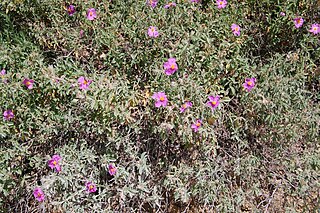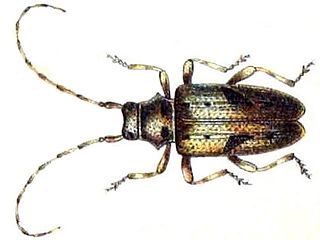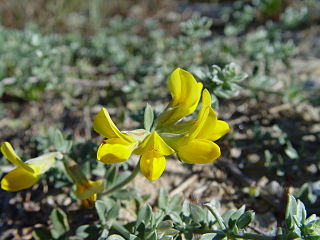Related Research Articles
Marcus Antonius Creticus, a member of the Antonius family, was a Roman politician during the Late Roman Republic. He is best known for his failed pirate-hunting career and for being the father of the general Mark Antony.
An agnomen, in the Roman naming convention, was a nickname, just as the cognomen had been initially. However, the cognomina eventually became family names, and so agnomina were needed to distinguish between similarly-named persons. However, as the agnomen was an additional and optional component in a Roman name, not all Romans had an agnomen.

Cistus creticus is a species of shrubby plant in the family Cistaceae. Though it usually has pink flowers, of 4.5–5 cm diameter, this species is very variable. It is widely known as a decorative plant. It is frequently called "Cistus incanus".
Quintus Caecilius Metellus Creticus was a politically active member of the Roman upper class. He was praetor in 74 BC and pontifex from 73 BC until his death. He was consul in 69 BC along with Quintus Hortensius Hortalus.
Quintus Caecilius Metellus Creticus Silanus, born Iunius Silanus was adopted by Quintus Caecilius Metellus, a descendant of the optimate Quintus Caecilius Metellus Creticus and the natural son of Marcus Junius Silanus. He was a Consul in AD 7 and governor of Syria from AD 13 to 17. Silanus was socially connected with the then-heir to the Roman principate Germanicus; his daughter at one time was betrothed to Germanicus' son Nero.

Pogonocherus hispidulus, the greater thorn-tipped longhorn beetle, is a species of flat-faced longhorns beetle in the family Cerambycidae.

Pogonocherus is a genus of flat-faced longhorn beetles in the family Cerambycidae.

Pogonocherini is a tribe of longhorn beetles of the subfamily Lamiinae.

Cistus × incanusL. is a hybrid between Cistus albidus and Cistus crispus. The name "Cistus incanus" has been used by other authors in a different sense, for Cistus creticus. The English name hoary rock-rose may refer to this species, among others.
Pogonocherus ovatoides is a species of beetle in the family Cerambycidae. It was described by Rapuzzi and Sama in 2014.

Pogonocherus ovatus is a species of beetle in the family Cerambycidae. It was described by Johann August Ephraim Goeze in 1777, originally under the genus Cerambyx. It has a wide distribution throughout Europe, although it has become extinct in several countries, including Luxembourg, Belgium and the Netherlands. It measures between 4 and 6 mm. It contains the varietas Pogonocherus ovatus var. subovatus.
Pogonocherus penicillatus is a species of beetle in the family Cerambycidae. It was described by John Lawrence LeConte in Agassizz in 1850. It is known from Canada and the United States.
Pogonocherus propinquus is a species of beetle in the family Cerambycidae. It was described by Fall in 1910. It is known from Canada and the United States.
Pogonocherus anatolicus is a species of beetle in the family Cerambycidae. It was described by Daniel in 1898. It is known from Syria, Cyprus, and Turkey.
Pogonocherus caroli is a species of beetle in the family Cerambycidae. It was described by Mulsant in 1863. It is known from France, Algeria, Tunisia, Spain, and Scotland.
Pogonocherus dimidiatus is a species of beetle in the family Cerambycidae. It was described by Blessig in 1873. It is known from Russia, China, North Korea, South Korea, and Japan.

Pogonocherus hispidus is a species of beetle in the family Cerambycidae. It was described by Carl Linnaeus in 1758, originally under the genus Cerambyx. It has a wide distribution throughout Europe and North Africa. It contains the varietas Pogonocherus hispidus var. rufescens.
Pogonocherus perroudi is a species of beetle in the family Cerambycidae. It was described by Mulsant in 1839. It has a wide distribution between Europe and North Africa. It feeds on several species of Pinus.
Pogonocherus sieversi is a species of beetle in the family Cerambycidae. It was described by Ganglbauer in 1886. It is known from Georgia, Turkey, Armenia and Ukraine.

Lotus creticus is a species of perennial herb of the family Fabaceae found in tropical Africa. It is symbiosis competent and engages in nitrogen-fixing symbiotic interactions with species of the Ensifer genus It comprises three varieties found in the Mediterranean although there is some controversy as to whether each subgroup could be considered the same species but are classically described as being subgroups. Varieties consist of the most commonly cited silky-hairy var. creticus which is widely distributed in its western part of the coast, the non-silky var. glabrescens which has a western Mediterranean distribution; and the eastern Mediterranean var. collinus which is also not silky and can be described by long petioles and peduncles.
References
- ↑ BioLib.cz - Pogonocherus creticus. Retrieved on 8 September 2014.